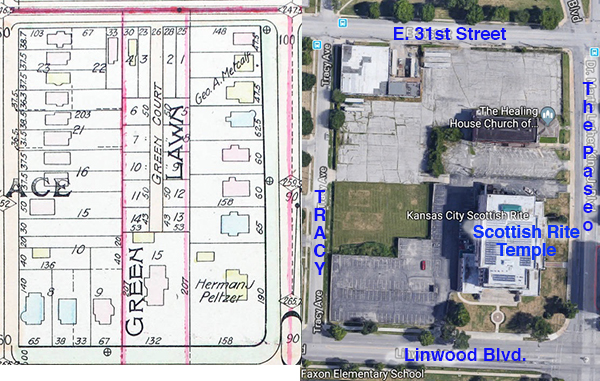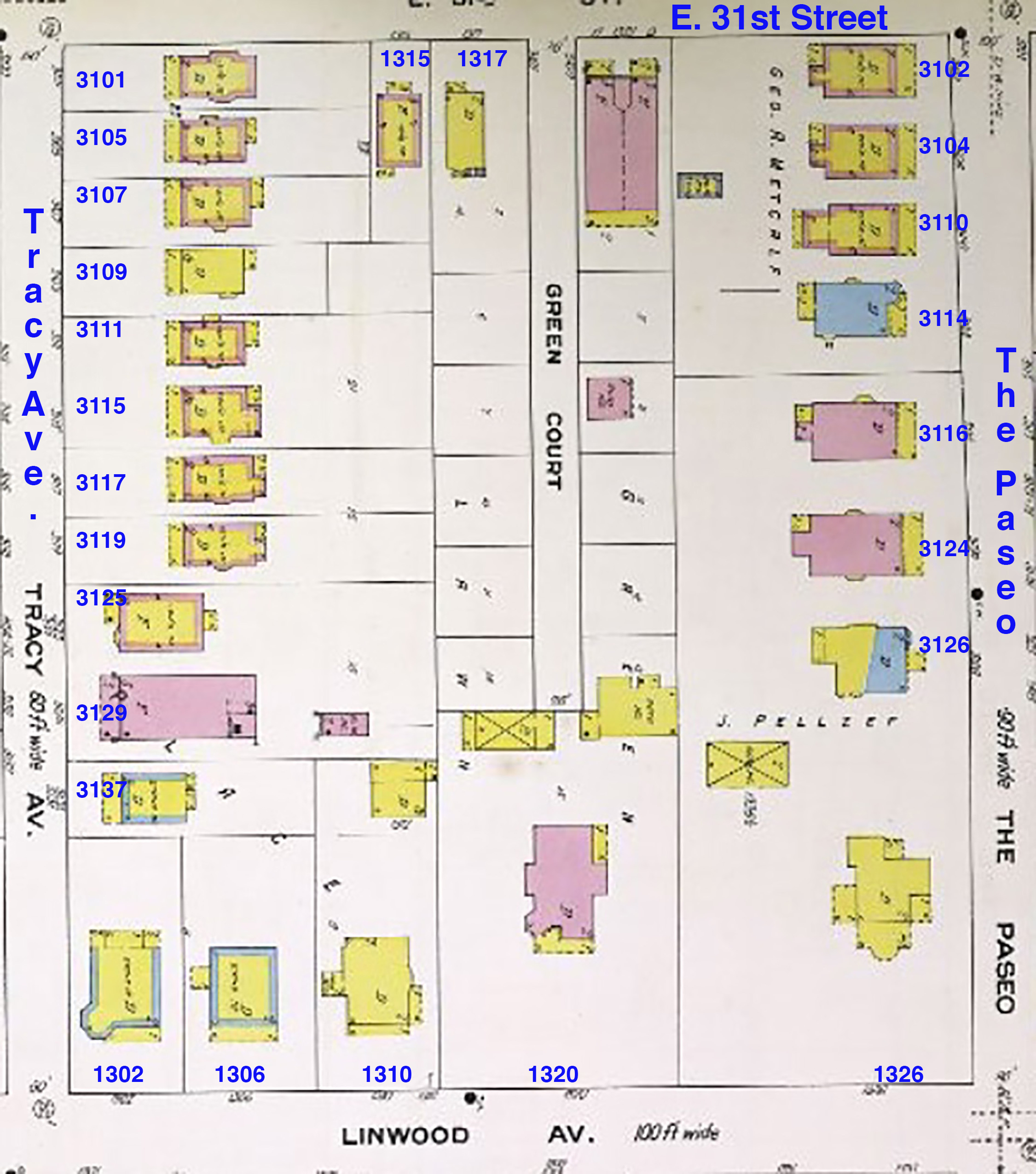
If location is all-important in real estate, location along two boulevards must be even better. The intersection of Linwood Boulevard and The Paseo (now called Martin Luther King, Jr. Boulevard) historically attracted elite families who moved into substantial homes before the turn of the 20th century. However, the location also made the block a target for commercial and institutional developers in the 192os.
This week’s featured block, from The Paseo (now called Martin Luther King, Jr. Boulevard) and Tracy between 31st Street and Linwood Boulevard, follows a familiar pattern across Midtown. From the 1880s to 1900, wealthy families moved south, spreading out along the newly created boulevards and often building mansions meant to last a century. But by the 1920s, many residents had also moved south and needed housing and new churches, schools, businesses, and institutions. Major streets such as The Paseo and Linwood naturally became the setting for these, and even relatively new homes along these key sites were often replaced by larger buildings.
As part of our Uncovering History Project, the Midtown KC Post is examining each block in Midtown. A set of 1940 tax assessment photos is available for many blocks.
Unfortunately, the Kansas City Public Library does not have the 1940s photos from the block of The Paseo and Tracy between 31st Street and Linwood Boulevard. For more about the Scottish Rite temple, see an earlier post.
In 1900, a Block of Well-Off Families
The Cowherd Company, which built many homes in Midtown, began selling new homes on the block in the late 1890s. The 1900 census shows well-off families had settled in, dominated by the large Peltzer home at the corner of Linwood and the Paseo. Theodore Peltzer, 62, was listed as a brick manufacturer. He shared the large house with his wife Gertrude, 45, two sons and a daughter. The census offers this snapshot of the neighbors on the block:
- 1310 Linwood: John Phillips, 65, lawyer; wife Fleecie, 66; daughter Hortense Feble, 35; son-in-law M. William Feble; granddaughter Helen Feble, 3; grandson F. John Feble, 7; black servant William Norman, 25; and white servant Dell Stimpson, 24.
- 1302 Linwood: James Fletcher,51, railroad manager; wife Ella, 50; daughter Eloise, 21; son Charles, 18; daughter Abbie, 15; sister-in-law Mary Talbott, 58, widowed.
- 3119 Tracy: Felix Kander, 56, lawyer; wife Matilda, 41; daughter Alice, 17; daughter Ruth, 15; son Harold, 14; son Allen, 10; black servant W. Sally Tuele, 25.
- 3117 Tracy: Eli Minerath, 40, merchandise broker; wife Bell, 34; son S. Irving, 8; daughter Lucile, 5; black servant Julia Henry, 24.
- 3115 Tracy: Samuel Cook, 43, hay dealer; wife Estella, 43; daughter Josephine, 2; white servant Mabelle McCulley, 19.
- 3111 Tracy: John Nuchols, 73, retired; wife Annie, 67; daughter Mrs. Howard McCreary, 46, widowed; black servant Cornelia Wilson, 25. Also, C. C. Hoyt, 47, a real estate man; wife Cara, 41; daughter L. Minnie, 17; son M. Sherman, 11; son Caron, 8; son George, 6.
- 3105 Tracy: Lee Campbell, 44, a commercial traveler; wife Marvell, 41; son W. Lee, 13; daughter L. Mary, 11; daughter Lorena, 7; black servant Cornelia Alexander, 44.
- 3113 Tracy: William Archer, 39; wife Alice, 33; son L. William, 11; son R. Virgil, 10; daughter E. Madalene, 8.
- 1315 E.31st: George Ogden, 45, coal merchant; wife L. Alice, 43; son Ralph, 19; daughter L. Olive, 17; daughter M. Helen, 14.
- 1317 E.31st: Jarvey Cannon, 49, mail carrier; wife Mary, 27; son C. James, 6; son John, 6; daughter Mary, 4; son Justine, 1.
- 1320 Linwood: Thomas Green, 63, grocer; wife Bridget, 57; daughter Elizabeth, 29; daughter Ellen, 27; son B. Thomas, 25, salesman; son M. James, 23, salesman; son W. Francis, 20, clerk; daughter C. Bernice, 19; black servant Hannah Hughes, 23; black servant Homer Davis, 17.
Changes Over the Decades
By 1915, the Peltzer family had moved on, selling the corner lot at Linwood and The Paseo. It was briefly considered an ideal site for an 11-story apartment building, part of a wave of luxury apartment hotels springing up across city boulevards. When Julius Davidson bought it in 1915, arts advocates tried to convince him it would be the perfect location for a music hall. In 1928, the Scottish Rite began constructing its new building, which still stands today.
As Kansas City’s population multiplied, many of the large older homes on the block were made into apartment or rooming houses as early as the late 1920s. In 1923, The United Brotherhood of Carpenters and Joiners, the largest union in Kansas City, bought the 10-room stone residence at 3114 Paseo and erected a new Carpenters Hall behind it. A chiropractor purchased the building next door in 1940 and remodeled it as office space. In 1939, Mrs. Nettie Shockley was arrested in a raid and fined for keeping a disorderly house and selling liquor without a city license at 1302 Linwood, perhaps signaling the decline of the block.

Historic photos courtesy Kansas City Public Library/Missouri Valley Special Collections.
Hi.
Do you have and pictures of Michigan Ave from 41st through 44th?
Hi. Please tell me what was the building behind the Scottish Rite temple? The front looks like a brick house with a church added on to it
My mother’s family lived at 4643 Tracy. Their last name was Dawson. Her grandmother, grandfather, and several of their children lived there including my mother’s mother. I think it might have been about 1910. The family had lived on an island in the Missouri River where most of them were born, the island was later submerged but the family moved to Kansas City and to Tracy where they went to school, most of them worked at electric park as young people. My mother’s mother married and had my mom. She divorced and stayed at Tracy and my mother was also raised there. I remember it as a young child and had such a good feeling being there. They have a few pictures of it. My grandmother moved to 5016 Lydia in about 1957. I think in the 1960’s the house was torn down, the steps were still there for quite awhile, I used to drive by just to remember the attachment I had to that house.